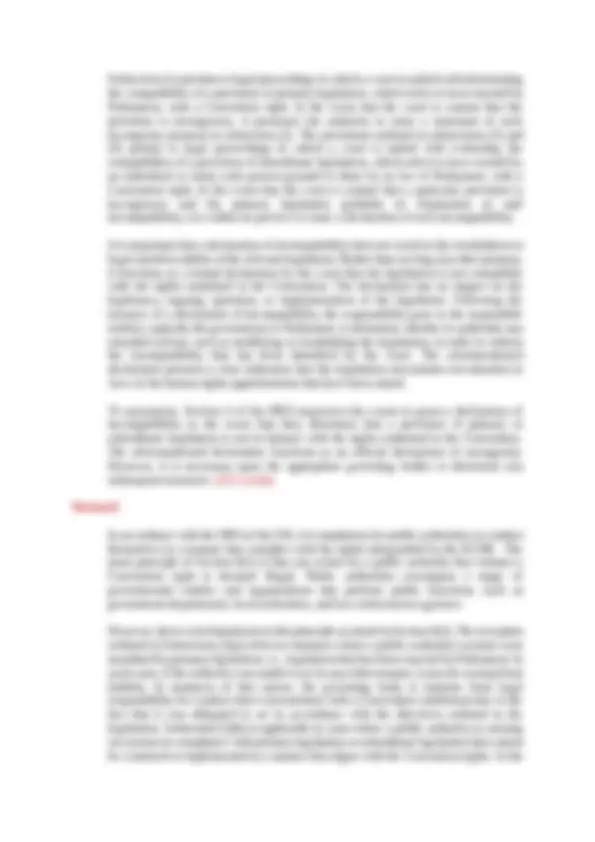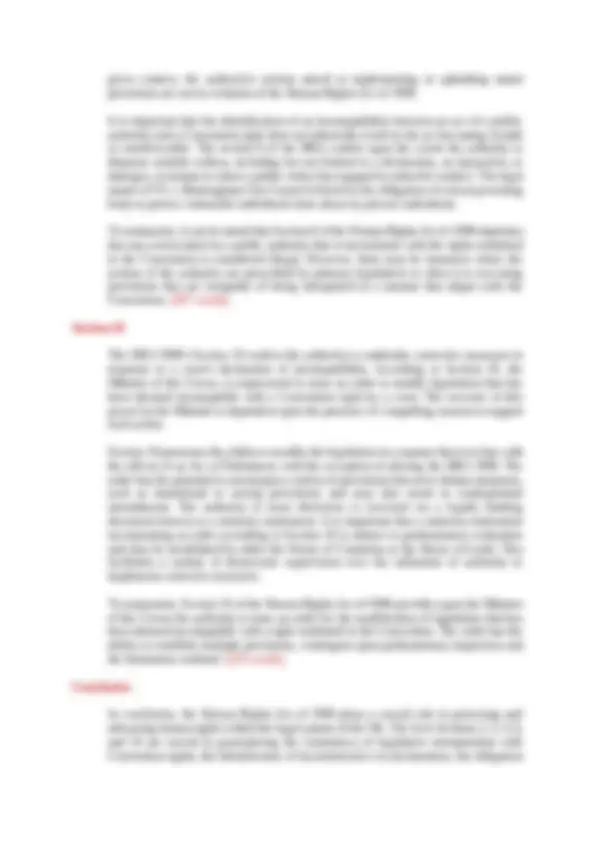





Study with the several resources on Docsity

Earn points by helping other students or get them with a premium plan


Prepare for your exams
Study with the several resources on Docsity

Earn points to download
Earn points by helping other students or get them with a premium plan
Community
Ask the community for help and clear up your study doubts
Discover the best universities in your country according to Docsity users
Free resources
Download our free guides on studying techniques, anxiety management strategies, and thesis advice from Docsity tutors
A comprehensive analysis of key sections of the human rights act 1998 (hra) in the uk, focusing on sections 2, 3, 4, 6, and 10. It delves into the practical application and interpretation of these sections, citing relevant case law and highlighting their significance in safeguarding human rights within the uk legal system. The duty of courts to interpret legislation in line with the european convention on human rights (echr), the power to issue declarations of incompatibility, the obligations of public authorities, and the mechanisms for addressing inconsistencies between legislation and convention rights.
Typology: Essays (university)
1 / 5

This page cannot be seen from the preview
Don't miss anything!




Human Rights General angle essay Introduction The Human Rights Act (HRA) was implemented in the UK in 1998, with the objective of incorporating the European Convention on Human Rights (ECHR) into the domestic law. This legislative measure has played a crucial role in strengthening the importance of protecting and advancing human rights within the UK legal system. The purpose of this essay is to provide a comprehensive evaluation of Sections 2, 3, 4, 6, and 10 of the HRA, scrutinizing their crucial provisions and examining their pragmatic consequences in safeguarding the rights of individuals. Furthermore, this essay will provide contextual perspectives on the practical application and interpretation of these sections by citing appropriate case law. (109 words) Section 2 The HRA 1998 contains a provision known as Section 2, which mandates that courts in the UK must consider the rights protected by the European Convention on Human Rights (ECHR) when construing legislation. This provision mandates that the judiciary must consider specific international legal sources, including rulings and determinations issued by the ECtHR and opinions expressed by the Commission, in construing statutes that pertain to an inquiry involving a Convention rights. It is imperative for the courts to take into account these sources whenever they hold relevance to the ongoing legal proceedings. It is important that the power to invalidate or strike down legislation that is deemed incompatible with the Convention rights is not conferred upon courts by Section 2 of the HRA 1998. In the event that a court determines that a particular provision of legislation is incompatible with a Convention right, it has the authority to waive a "declaration of incompatibility" according to Section 4 of the HRA 1998. The aforementioned declaration functions as a formal declaration that the legislation is incompatible with the rights outlined in the Convention. However, the responsibility of modifying or revoking the legislation lies with the Parliament. It is widely held that legislation ought to be construed in a manner that aligns with the rights enshrined in the Convention. The imperative is for courts to endeavor towards an interpretation of legislation that maintains and demonstrates deference towards the rights safeguarded by the Convention. The principle in question was established in the prominent legal case of R (on the application of Ullah) v Special Adjudicator. The section 2 of the Human Rights Act of 1998 outlines the obligation of courts and tribunals to interpret legislation in a manner that aligns with the Convention rights. This involves considering important international legal sources, unless such an approach is impossible. (303 words) Section 3 Section 3 of HRA is a significant provision that pertains to the construal of legislation in the UK in a manner that complies with the rights protected under the ECHR. The
principle of interpretation enshrined in Section 3(1) stipulates that primary legislation, which refers to laws passed by Parliament, and subordinate legislation, which refers to laws formulated by an individual or entity under the authority granted to them by an Act of Parliament, ought to be construed in a manner that is consistent with the rights safeguarded by the ECHR to the greatest extent possible. The judicial system is obligated to construe statutes in a manner that safeguards and advances human rights, to the extent that it is practically achievable within the confines of the statute's wordings and objective. Nevertheless, it is important that Section 3(2) presents significant stipulations to this fundamental principle. Section 3(2)(a) unambiguously stipulates that the applicability of Section 3 extends to all primary and subordinate legislation, irrespective of the time of its enactment. This guarantees that the responsibility of interpreting pertains to both existing and the future statutes. Section 3(2)(b) stipulates that the responsibility of interpreting the law does not invalidate or hinder the validity, ongoing operation, or implementation of any primary legislation that contradicts the rights enshrined in the Convention. Stated differently, the aforementioned provision does not confer upon the judiciary the authority to invalidate statutes that are deemed incompatible with fundamental human rights. According to Section 3(2)(c), the duty of interpretation does not impact the legitimacy, ongoing operation, or implementation of any subordinate legislation that contradicts the rights outlined in the Convention, unless there exists primary legislation that prohibits the elimination of such incompatibility. In cases where primary legislation prohibits the rectification or modification of incompatible subordinate legislation, the latter retains its legal validity and enforceability despite the lack of compatibility. Section 3 is particularly relevant in situations where there exists a degree of ambiguity or uncertainty in the wordings employed within legislative documents. In instances of this nature, it is within the authority and obligation of the courts to interpret the legislation in a manner that complies with the rights enshrined in the Convention. The principle in question was established in the legal case of R v A (No 2). The House of Lords determined that Section 3 permits a "purposive" interpretation in order to prevent any contradictions with the rights outlined in the Convention. To summarize, Section 3 of the Human Rights Act of 1998 imposes a duty on courts to interpret legislation in a manner that is consistent with the Convention rights to the maximum extent possible. Notwithstanding, the aforementioned provision does not confer upon courts the authority to invalidate incompatible legislation, and the responsibility of interpreting said provision is circumscribed by the restrictions outlined in subsection (2). (467 words) Section 4 The Human Rights Act 1998 (HRA 1998) includes a provision in Section 4 that enables the courts in the UK to issue a "declaration of incompatibility" in the event that they determine a legislative provision to be incompatible with the rights safeguarded under the ECHR. Section 4 defines the authority of the judiciary to render a issue of incompatibility within the legal framework.
given context, the authority's actions aimed at implementing or upholding stated provisions are not in violation of the Human Rights Act of 1998. It is important that the identification of an incompatibility between an act of a public authority and a Convention right does not inherently result in the act becoming invalid or unenforceable. The section 8 of the HRA confers upon the courts the authority to dispense suitable redress, including but not limited to a declaration, an injunction, or damages, in instances where a public entity has engaged in unlawful conduct. The legal matter of YL v. Birmingham City Council referred to the obligation of a local governing body to protect vulnerable individuals from abuse by private individuals. To summarize, it can be stated that Section 6 of the Human Rights Act of 1998 stipulates that any action taken by a public authority that is inconsistent with the rights enshrined in the Convention is considered illegal. However, there may be instances where the actions of the authority are prescribed by primary legislation or when it is executing provisions that are incapable of being interpreted in a manner that aligns with the Convention. (407 words) Section 10 The HRA 1998's Section 10 confers the authority to undertake corrective measures in response to a court's declaration of incompatibility. According to Section 10, the Minister of the Crown, is empowered to issue an order to modify legislation that has been deemed incompatible with a Convention right by a court. The exercise of this power by the Minister is dependent upon the presence of compelling reasons to support such action. Section 10 possesses the ability to modify the legislation in a manner that is in line with the effects of an Act of Parliament, with the exception of altering the HRA 1998. The order has the potential to encompass a variety of provisions that serve distinct purposes, such as transitional or saving provisions, and may also result in consequential amendments. The authority to issue directives is executed via a legally binding document known as a statutory instrument. It is important that a statutory instrument incorporating an order according to Section 10 is subject to parliamentary evaluation and may be invalidated by either the House of Commons or the House of Lords. This facilitates a system of democratic supervision over the utilization of authority to implement corrective measures. To summarize, Section 10 of the Human Rights Act of 1998 provides upon the Minister of the Crown the authority to issue an order for the modification of legislation that has been deemed incompatible with a right enshrined in the Convention. The order has the ability to establish multiple provisions, contingent upon parliamentary inspection and the limitations outlined. (255 words) Conclusion In conclusion, the Human Rights Act of 1998 plays a crucial role in protecting and advancing human rights within the legal system of the UK. The Act's Sections 2, 3, 4, 6, and 10 are crucial in guaranteeing the consistency of legislative interpretation with Convention rights, the identification of inconsistencies via declarations, the obligation
of public authorities to comply with human rights, and the safeguarding of freedom of expression. Through the adoption and implementation of these regulations, the country persists in its pursuit of a society that is more comprehensive and connected to human rights, in which the integrity and basic liberties of each person are protected and maintained. (109 words)